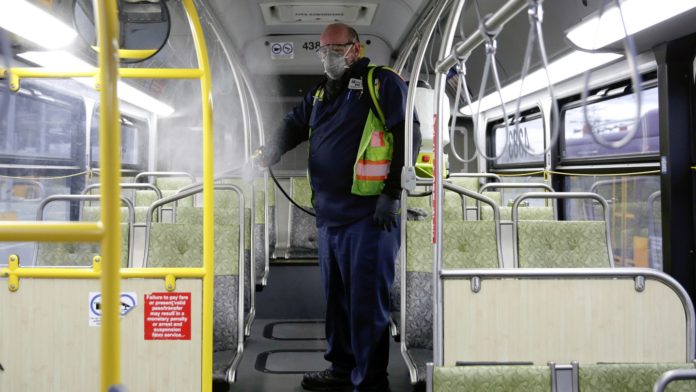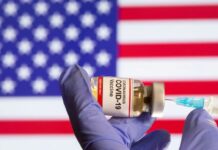For the professionals who try to manage homeland-security threats, reassuring the public after a natural disaster or terrorist attack—or amid a coronavirus outbreak like the one the world now faces—is just part of the job. I am a former federal and state homeland-security official. I study safety and resiliency issues in an academic setting, advise companies on their emergency-response plans, and trade ideas with people in public health, law enforcement, and many other disciplines. Since the beginning of the disease now known as COVID-19, I’ve also been receiving more and more text messages from nervous relatives and friends. The rash decisions that panic breeds have never made any emergency better. So like many others in my field, I’ve been urging people, in as calm a tone as I can muster, to listen to experts and advising them about concrete steps they can take to keep their families, communities, and businesses safe.
Wash your hands. Don’t touch your face. Avoid large gatherings. Don’t panic, and prepare as best you can.
Advice like mine is meant to be empowering, but now I fear it may also be misleading. If Americans conclude that life will continue mostly as normal, they may be wrong. The United States is far less prepared than other democratic nations experiencing outbreaks of the novel coronavirus. Low case counts so far may reflect not an absence of the pathogen but a woeful lack of testing.
Disruptions are almost certain to multiply in the weeks to come. Airlines are scaling back flights. Conferences, including Austin’s signature event, South by Southwest, are being canceled. The drop in imports is hurting global supply chains. Corporations are prohibiting their employees from traveling and attending mass gatherings. Stanford University just canceled its in-person classes for the rest of the winter quarter, and other institutions are likely to take similar steps. Government agencies and private companies alike will activate continuity-of-operations protocols, as they are called in my field. Get used to it.
Aggressive steps are essential to protecting the public from a deadly virus. Last week, the World Health Organization assessed the fatality rate at a shocking 3.4 percent, much higher than previously believed. Early on, many American medical experts withheld judgment about the limited data coming out of China, but information from around the world has now confirmed how severe COVID-19 is and how rapidly it is spreading. As Dr. Margaret Bordeaux, my colleague at the Security and Global Health Project at Harvard’s Kennedy School, told me, “None of us want to be Chicken Little, but there is too much consistent data to not begin to rattle the cage pretty loudly.”
Even if the United States were far more ready for COVID-19, the consequences could still be grievous. In my field, adequate preparation means having the plans, money, equipment, and expertise in place to avert all but a tiny percentage of the harms that might otherwise occur. Yet because of the nature of pandemics, even a level of preparation that looks robust to homeland-security experts could still fail to prevent thousands of deaths.
I live in Massachusetts. During the Boston Marathon bombing in 2013, three people died at the finish line, as two homemade bombs ripped through the crowd of spectators. It was a tragedy for their families and the people of Boston. Nearly 300 other people were injured. Fortunately, the city has a large number of hospitals with excellent trauma centers and was therefore unusually well prepared for such an emergency. Some people were treated on the scene; 127 others—many of whom lost limbs—were transported to local hospitals. Not a single patient who survived the initial blast died. Was this good news? Unequivocally yes. The efforts of so many first responders and health professionals, and the public, saved those who might have otherwise died. But success is relative. That even careful preparations could still leave some people dead and others badly harmed is both a fact of life and appalling to accept.
A threat as dire as the new coronavirus exposes the weaknesses in our society and our politics. If Americans could seek testing and care without worrying about co-pays or surprise bills, and if everyone who showed symptoms had paid sick leave, the United States could more easily slow the spread of COVID-19. But a crisis finds a nation as it is, not as its citizens wish it to be.
The coronavirus—and the measures enacted to stop it—could quickly change the rhythms of Americans’ daily lives. The United States is seeing its first deaths, first emergency declarations, first school closings, first mandatory work-at-home policies. If the number of COVID-19 cases spikes quickly, hospitals could soon be deluged with patients seeking care. This is a predictable consequence of any epidemic, but few Americans’ personal experience gives them any reason to understand how disruptive these changes could be if the epidemic continues to worsen.
Ironically, the officials now urging citizens to keep calm understand far more acutely than the general public how much else can go wrong. A municipal police chief in the Boston area recently urged me to imagine that a school district closed for even three weeks. Take just one child, raised by a single parent who is a police officer. The child is home, so the parent must stay home. Other officers in the same patrol will be affected even if they don’t have kids in school. Shifts will change, nonessential functions will be put off, and the department will have less flexibility to respond to problems unrelated to the epidemic—even as, with more teens unsupervised, rates of car accidents and certain crimes could well increase.
Emergency-response officials are hesitant to play out these dangers in public. This police chief asked me not to identify him because, like so many others in positions of responsibility, he worries that misgivings like his will become self-fulfilling prophecies—that citizens will panic if their local authorities give voice to their own doubts.
Meanwhile, President Donald Trump and his administration have vacillated between ignoring the threat and making wildly unrealistic promises about it. On Wednesday, Vice President Mike Pence promised 1.5 million coronavirus tests, but The Atlantic reported Friday that, according to all available evidence, fewer than 2,000 had been conducted in the United States. Trump himself is simply lying about basic facts about the COVID-19 response; despite the testing kit shortfall, he has publicly stated that everyone who wants to get tested can get tested.
China’s aggressive containment of the new virus in the early weeks of this year gave other nations time to ready themselves for what was inevitably going to come: a shortage of test kits and personal protective equipment for a virus that spreads as quickly and causes as many deaths and hospitalizations as COVID-19 does.
The United States wasted that opportunity. Trump’s initial impulse to downplay the risk, at least until the stock market took note, wasn’t just fanciful; it was dangerous. He has consistently minimized the number of sick, blamed Barack Obama’s administration for a shortage of test kits, and publicly mused about the potential of a vaccine being found quickly. The American response to the new disease should be based on something more than hunches and magical thinking.
The whole time, people like me have been dutifully advising friends, family, and everyone else to take prudent precautions and avoid panicking. That’s still good advice, because any measures that slow the spread of the disease and lower the death rate could save thousands of lives. But Americans should also understand that even the best preparation humanly possibly wouldn’t be perfect—and that what the United States has done so far falls far short of that. Especially at this point, even a more vigorous response will not preclude a lot of people from getting sick. Preventing all infections is no longer a possibility, and the measure of success is how much public-health authorities can reduce the number of people who die or fall seriously ill.









